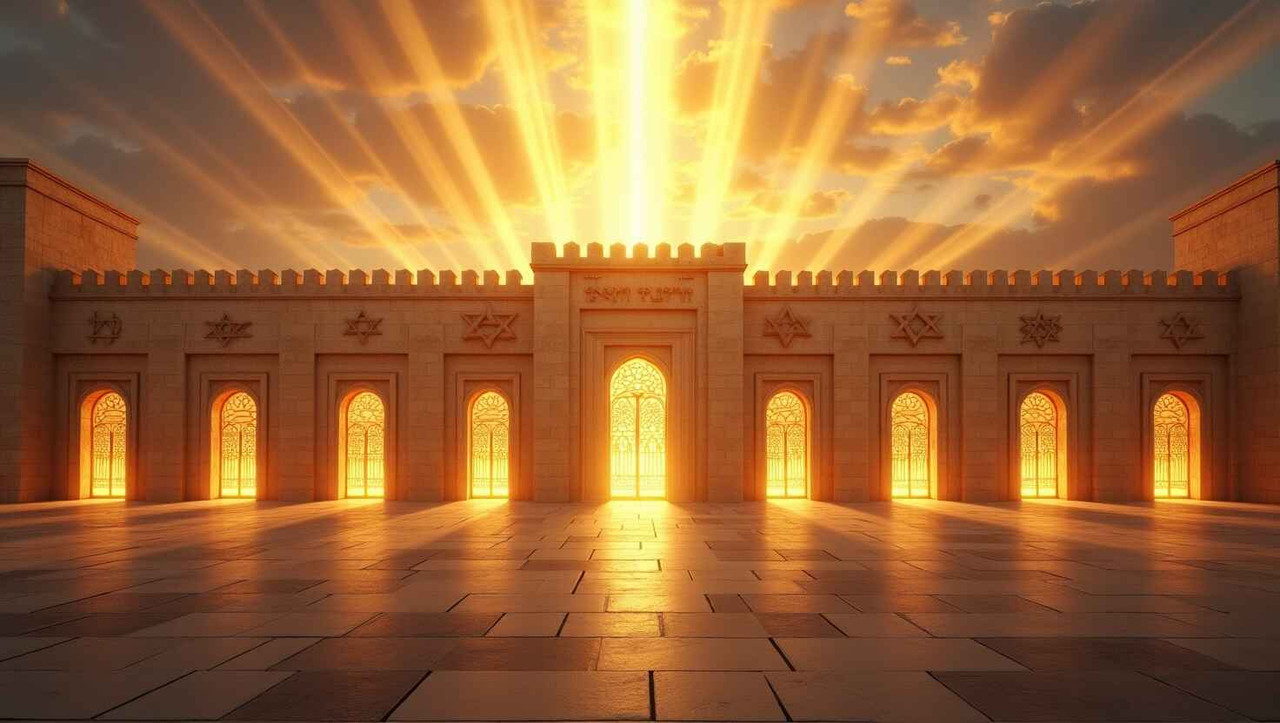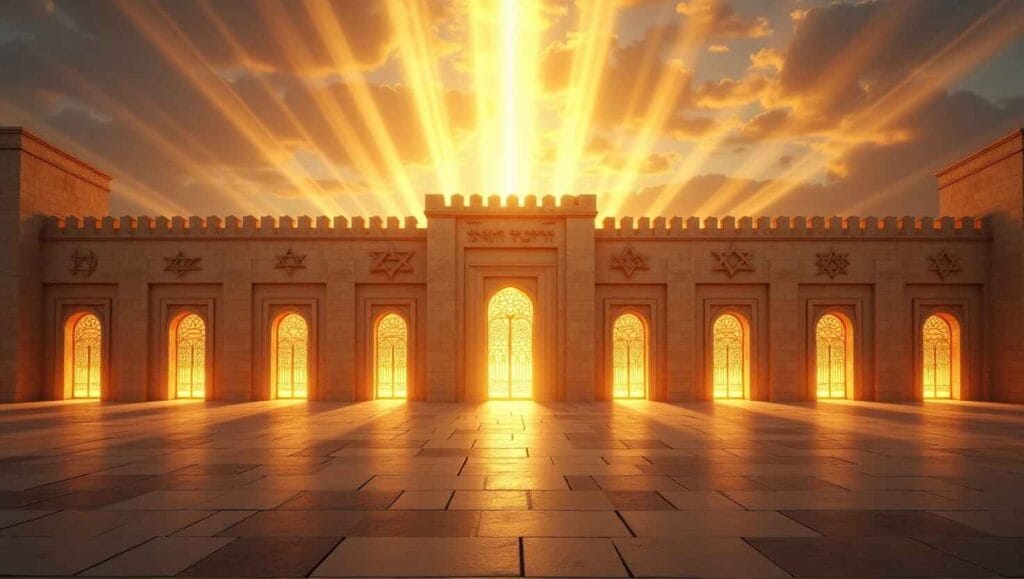
Jerusalem Twelve Gates, One Pattern: Unveiling Heaven’s Order in 12 Jerusalem’s Walls
Chapter 1: The Number Twelve – A Pattern of Divine Government
Discover the biblical significance of the number twelve and how it reflects divine order in God’s Kingdom.
The number twelve frequently appears in Scripture as a symbol of divine authority and governmental perfection. From the twelve tribes of Israel to the twelve apostles, it illustrates God’s complete order. In the gates of Jerusalem, twelve represent the fullness of God’s covenant and His structured plan to bring His people into spiritual maturity and heavenly alignment.
Chapter 2: The Gates in Nehemiah – Rebuilding Revelation
A look at the spiritual meaning behind the gates in Nehemiah’s wall and their prophetic message for believers.
Nehemiah’s mission to rebuild Jerusalem’s broken walls was not just about physical restoration—it was a prophetic act. Each gate he repaired mirrored a spiritual truth. His orderly restoration process speaks to how God rebuilds lives: strategically, purposefully, and with prophetic intention.
Chapter 3: The Sheep Gate – The Portal of Redemption
Explore the redemptive work of Christ symbolized through the Sheep Gate—our entry point into salvation.
The Sheep Gate was the first to be repaired and dedicated, emphasizing the priority of redemption. It was near the temple and used for sacrificial animals, symbolizing Jesus Christ as the Lamb of God. This gate calls every believer to begin their journey through faith in Christ’s redemptive work.
Chapter 4: The Fish Gate – Evangelism and the Call to Discipleship
Uncover your calling as a fisher of men through the message of the Fish Gate and New Testament evangelism.
Just as Jesus called His disciples to be “fishers of men,” the Fish Gate reminds us of our calling to evangelize. It is the gateway through which we extend the message of salvation to others, embodying the spirit of discipleship and multiplication.
Chapter 5: The Old Gate – Returning to Ancient Paths
A call to return to foundational truths and time-tested spiritual disciplines of the faith.
This gate represents foundational truth. It calls believers to return to the timeless principles of God’s Word, resisting modern distortions. The Old Gate urges us to walk in obedience and wisdom, following the proven paths laid by spiritual fathers.
Chapter 6: The Valley Gate – Embracing Humility and Brokenness
Journey through the Valley Gate, a place of surrender and spiritual humility in the believer’s life.
The Valley Gate leads to low places, symbolic of trials and humility. Every believer must pass through this gate to be refined. Brokenness is not the end, but the preparation for deeper intimacy with God and greater spiritual authority.
Chapter 7: The Dung Gate – Purging the Old to Embrace the New
Learn the importance of spiritual cleansing and removing what no longer aligns with God’s purpose.
This unpleasant-sounding gate represents purification. It was where waste was removed from the city. Spiritually, it signifies the process of sanctification—discarding sin, past shame, and emotional baggage to make room for new life.
Chapter 8: The Fountain Gate – The Outpouring of the Holy Spirit
Discover the empowerment of the Holy Spirit and its refreshing flow through the Fountain Gate.
Situated near the Pool of Siloam, the Fountain Gate speaks of the living water—symbolic of the Holy Spirit. It’s a place of refreshing, healing, and empowerment. Passing through this gate represents entering into a Spirit-filled life.
Chapter 9: The Water Gate – Washed by the Word
Understand the power of Scripture in purifying and guiding the believer’s daily walk.
In Nehemiah, this is where Ezra read the law to the people. It symbolizes the cleansing, guiding, and nourishing power of God’s Word. A life without the Water Gate will lack direction, purity, and strength.
Chapter 10: The Horse Gate – Strength, Warfare, and Readiness
Engage in spiritual warfare with the readiness and strength God provides at the Horse Gate.
Horses were used for battle, and this gate represents spiritual warfare and readiness. As believers mature, they are called to engage in intercession and spiritual authority. The Horse Gate demands a life of discipline, courage, and endurance.
Chapter 11: The East Gate – Awaiting the Glory and the King’s Return
Look ahead to the return of Christ as symbolized by the glorious East Gate in Jerusalem.
The East Gate holds eschatological importance—it is the gate through which the Messiah is prophesied to return. This gate reminds believers to live with expectation, hope, and holiness as we await the return of Christ in glory.
Chapter 12: The Miphkad Gate – Judgment, Inspection, and Reward
A reminder of divine accountability, spiritual inspection, and eternal reward at the final gate.
“Miphkad” means assignment or numbering. This gate represents the place of inspection or reckoning. It is where God evaluates our works—not for condemnation, but reward. It challenges us to live with purpose and accountability.
Chapter 13: More Another Gates – Ephraim & The Prison Gate (Mercy and Restoration)
Explore the lesser-known gates that symbolize mercy, second chances, and God’s restoring grace.
Ephraim, often representing fruitfulness, and the Prison Gate, symbolizing release and restoration, are additional gates that speak of God’s mercy. These gates remind us that God not only delivers us but restores what was lost and multiplies our fruitfulness.
Chapter 14: The Twelve Gates in Prophetic Alignment
See how the 12 gates align prophetically with Scripture from Genesis to Revelation.
Each gate points to a spiritual truth, and when aligned prophetically, they form a pattern that mirrors the heavenly Jerusalem. These gates serve as a prophetic timeline and discipleship framework—from salvation to eternal glory. Their order is intentional, and their symbolism is foundational for today’s Church.
Chapter 15: Walking Through the Gates – A Spiritual Blueprint for Today’s Believer
Apply the spiritual lessons of each gate in your personal walk with Christ today.
Ultimately, this series is more than history—it’s a spiritual blueprint. Every believer is invited to walk through these gates, embracing each stage of growth and transformation. From the moment of salvation to the anticipation of Christ’s return, the gates map the entire journey of faith.
Conclusion: Living Inside the Walls of God’s Design
The Twelve Gates of Jerusalem serve as powerful metaphors for the believer’s walk with Christ. They are not just historical artifacts or prophetic visions—they are a call to personal transformation. As you walk through each gate in prayer, study, and life, you step deeper into the heart of God’s redemptive plan. He is building a city—a spiritual people—whose gates are open, fortified, and aligned with heaven.
Let us not just admire the gates from a distance. Let us enter in, be transformed, and build others up along the way. Heaven’s order is waiting to be revealed in and through you.
For readers seeking to dive deeper into the heart of biblical truths and Christ-centered living, we invite you to explore our dedicated resource hub: Jesus for Everyone. This collection of devotionals, teachings, and spiritual insights is designed to equip believers at every stage of their faith walk. Whether you’re reflecting on the spiritual lessons from Jerusalem’s gates or exploring themes of redemption and restoration, these articles offer wisdom grounded in Scripture. For broader theological context, resources like GotQuestions.org offer helpful explanations on biblical topics. Stay rooted in truth and return often to We Love God Daily as your trusted destination for growth, encouragement, and biblical alignment.

The Significance of the Jerusalem Twelve Gates in Biblical Prophecy
The Jerusalem Twelve Gates hold deep symbolic and prophetic meaning in both Jewish and Christian traditions. These gates, referenced in the Book of Revelation and rooted in Old Testament history, are more than architectural features—they represent divine order, access, and covenant fulfillment. Understanding the Jerusalem Twelve Gates allows believers to grasp a clearer vision of God’s eternal plan.
In the ancient city, the Jerusalem Twelve Gates served practical purposes for trade, defense, and worship. Each gate had a name and a specific function, and several were mentioned in Nehemiah during the rebuilding of the city walls. However, the prophetic vision of the Jerusalem Twelve Gates as described in Revelation 21 carries a far deeper meaning. In that vision, the Jerusalem Twelve Gates are part of the New Jerusalem—the Eternal City—where each gate is made of a single pearl and is inscribed with the names of the twelve tribes of Israel.
The Jerusalem Twelve Gates symbolize inclusion and covenant. They show that God’s promises to the twelve tribes of Israel are eternal and honored in the new creation. These gates are not shut—they remain open, welcoming all whose names are written in the Lamb’s Book of Life. The open Jerusalem Twelve Gates signify a kingdom without fear, division, or darkness.
Moreover, the number twelve is not incidental. It is used consistently in Scripture to represent divine governance and completeness. The Jerusalem Twelve Gates, paired with the twelve foundation stones named after the apostles, reveal the unity of Old and New Covenants. The Jerusalem Twelve Gates speak of continuity—God’s one redemptive plan from Genesis to Revelation.
Spiritually, the Jerusalem Twelve Gates are also an invitation. They point to the access believers now have to God’s presence through Jesus Christ. No longer do people need to stand outside or offer sacrifices to enter. Christ has become our access, and the Jerusalem Twelve Gates are the fulfillment of that divine accessibility.
Many biblical scholars also connect the Jerusalem Twelve Gates with the characteristics of the Church. Each gate, while part of the same wall, offers unique perspective and beauty—just as each believer brings something distinct to the body of Christ. The Jerusalem Twelve Gates remind us that the Church is diverse, united, and secured in God’s eternal plan.
In times of turmoil, the vision of the Jerusalem Twelve Gates brings hope. It shows a future where peace, purity, and presence with God are permanent. No more broken gates, no more enemies—just everlasting communion with the Lord.
In conclusion, the Jerusalem Twelve Gates are more than an end-times vision—they are a powerful reminder of God’s faithfulness, inclusivity, and eternal purpose. As believers reflect on the Jerusalem Twelve Gates, may they find assurance in the security and beauty of the city God has prepared for His people.
